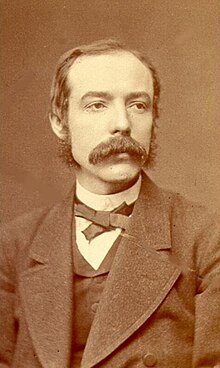Georg Hermann Quincke
Georg Hermann Quincke | |
|---|---|
 Quincke, c. 1860 | |
| Born | 19 November 1834 |
| Died | 13 January 1924 (aged 89) |
| Nationality | German |
| Known for | Streaming current Quincke's interference tube |
| Awards | ForMemRS (1879) |
| Scientific career | |
| Fields | Physics |
| Thesis | De constantibus mercurii capillaribus (1858) |
| Doctoral advisor | H. G. Magnus, F. E. Neumann |
| Doctoral students | K. F. Braun, P. Lenard |
| Other notable students | Albert A. Michelson[1] |
Georg Hermann Quincke
.Biography
Born in Frankfurt-on-Oder, Quincke was the son of prominent physician Geheimer Medicinal-Rath Hermann Quincke and the elder brother of physician Heinrich Quincke.
Quincke received his
In September 1860, Quincke was one of the participants in the Karlsruhe Congress, the first international conference of chemistry worldwide. He and Adolf von Baeyer represented the University of Berlin in Congress.
Quincke also did important work in the experimental study of the reflection of light, especially from metallic surfaces, and carried on prolonged researches on the subject of the influence of electric forces upon the constants of different forms of matter, modifying the dissociation hypothesis of Clausius.
Quincke's Interference Tube is an apparatus that Quincke built in 1866 which demonstrates destructive interference of sound waves. It is also known as the Herschel-Quincke Tube; John Herschel had proposed a similar apparatus, but did not build it. The principles of the apparatus are now applied in mufflers and other noise management devices.[2][3][4]
Quincke received a
Quincke died in Heidelberg at the age of 89 years. He is believed to be the last living participant of the Karlsruhe Congress.
Notes
- ^ Loyd S. Swenson Jr., The Ethereal Aether, University of Texas Press, 2013.
- ISBN 9783110966305.
- OCLC 924543401.
- ^ Quincke's Interference Tube Physics; University of Michigan
See also
References
- Georg Hermann Quincke at the Mathematics Genealogy Project
 This article incorporates text from a publication now in the New International Encyclopedia. 1905.
This article incorporates text from a publication now in the New International Encyclopedia. 1905.
